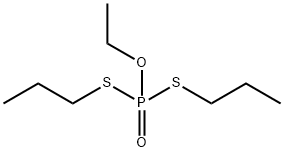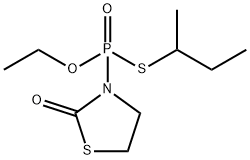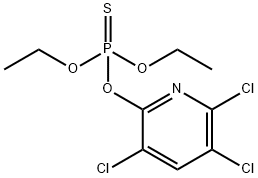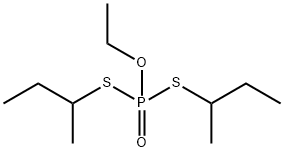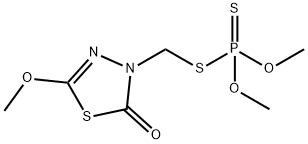Oxydemeton-methyl
- CAS NO.:301-12-2
- Empirical Formula: C6H15O4PS2
- Molecular Weight: 246.28
- MDL number: MFCD00055488
- EINECS: 206-110-7
- SAFETY DATA SHEET (SDS)
- Update Date: 2025-01-27 09:38:02
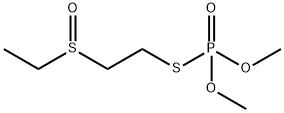
What is Oxydemeton-methyl?
Description
Oxydemeton-methyl, i.e., demeton-S-methyl sulfoxide, is a colorless oil, bp 106 ?C/0.01 mm Hg, vp 3.8 mPa (20 ?C). It is miscible with water and soluble in most organic solvents, except petroleum ether. Log Kow = ?0.74(21 ?C). Oxydemeton-methyl is relatively stable in acidic media but hydrolyzed in alkalinemedia;DT50 values (22 ?C) at pH 4, 7, and 9 are 107, 46, and 2 d, respectively.
Chemical properties
Oxydemeton methyl is a colorless to amber-colored liquid.
Oxydemeton methyl is relatively slowly hydrolyzed in acidic
media, but rapidly hydrolyzed in alkaline media.
Oxydemeton methyl is miscible with
water; readily soluble (10–100 g/
100 mL) in dichloromethane,
2-propanol, and toluene; and practically
insoluble (<1 g/100 mL) in n-hexane.
The Uses of Oxydemeton-methyl
Oxydemeton-methyl is used to control sucking insects on fruit, vines, vegetables, cereals and ornamentals.
The Uses of Oxydemeton-methyl
A metabolite of Demeton-S-methyl (D231370). An organophosphorus pesticide biomarker.
The Uses of Oxydemeton-methyl
Systemic and contact insecticide and acaricide used to control spider mites and other insects on vegetables and some ornamentals.
Definition
ChEBI: Oxydemeton-methyl is an organic thiophosphate and an organothiophosphate insecticide. It has a role as an EC 3.1.1.7 (acetylcholinesterase) inhibitor, an acaricide and an agrochemical. It is functionally related to a 2-(ethanesulfinyl)ethanol.
General Description
Clear amber liquid.
Air & Water Reactions
Water soluble. DEMETON-S-METHYL SULFOXIDE may be rapidly hydrolyzed by alkali .
Reactivity Profile
Organophosphates such as DEMETON-S-METHYL SULFOXIDE are susceptible to formation of highly toxic and flammable phosphine gas in the presence of strong reducing agents such as hydrides. Partial oxidation by oxidizing agents may result in the release of toxic phosphorus oxides.
Fire Hazard
DEMETON-S-METHYL SULFOXIDE is flammable.
Safety Profile
Poison by ingestion, skin contact, intravenous, and intraperitoneal routes. Human mutation data reported. When heated to decomposition it emits very toxic fumes of POx and SOx. See also other demeton entries.
Environmental Fate
Soil. The sulfoxide group is oxidized to the sulfone and oxidative and hydrolytic
cleavage of the side chain gives dimethylphosphoric and phosphoric acids (Hartley and
Kidd, 1987). Oxamyl was degraded by the microorganism Pseudomonas putida in a
laboratory study using cultured bacteria (Zeigler, 1980).
Plant. In asparagus, oxydemeton-methyl was converted to the corresponding sulfone
(Szeto and Brown, 1982).
Chemical/Physical. Oxydemeton-methyl can be converted to the corresponding sulfone
by hydrogen peroxide (Cremlyn, 1991). Emits toxic fumes of phosphorus and sulfur oxides
when heated to decomposition (Sax and Lewis, 1987).
Metabolic pathway
Oxydemeton-methyl is the primary thiooxidation metabolite of demeton- S-methyl. It is further oxidised rapidly to demeton-Smethylsulfon in all media. The major route of further metabolism of both sulfoxide and sulfone is via hydrolysis to the sulfoxide and sulfone thiols. Stage I1 metabolism of these thiol hydrolysis products proceeds via oxidation and conjugation and is different in soil, plants and animals. In plants the thiols are conjugated, whereas in animals they are mainly methylated and oxidised to sulfoxides, sulfones and sulfonic acids. Demethylation is an important route in mammals; however, the compound is sufficiently polar for much to be excreted in the urine unchanged. Demethylation has also been reported to occur in plants.
Metabolism
Almost 99% of orally administered oxydemeton-methyl to animals is excreted within 48 h in the urine. It is oxidized to the sulfone, followed by hydrolytic cleavage of the P?S bond. The thiol metabolites are conjugated or methylated. O-Demethylation is also an important degradation route both inmammals and plants. Oxydemeton-methyl is rapidly degraded in soils.
Degradation
Oxydemeton-methyl is relatively slowly hydrolysed in acidic media but rapidly hydrolysed under alkaline conditions. Half-lives at pH values 4,7 and 9 were 107,46 and 2 days respectively (PM). Under sterile aqueous conditions oxydemeton-methyl was degraded to give the oxidised hydrolysis product bis[2-(ethylsulfinyl)ethyl] disulfide (2) (Ziegler et al., 1980) (Scheme 1).
Toxicity evaluation
The acute oral LD50 for rats is about 50 mg/kg. Inhalation LC50 (4 h) for rats is 0.47 mg/L air. NOEL (2 yr) for rats is 1 mg/kg diet (0.05 mg/kg/d). ADI is 0.3 μg/kg b.w. for the sum of oxydemeton-methyl, demeton-S-methylsulfone, and demeton-S-methyl.
Properties of Oxydemeton-methyl
| Melting point: | <-20℃ |
| Boiling point: | 106 °C(Press: 0.01 Torr) |
| Density | 1.289 g/cm3 (20 ºC) |
| vapor pressure | 3.8×10-3 Pa (20°C) |
| refractive index | 1.5216 (589.3 nm 20℃) |
| storage temp. | 0-6°C |
| solubility | Chloroform (Sparingly), Ethyl Acetate (Slightly), Methanol (Slightly) |
| form | Oil |
| Water Solubility | Miscible |
| color | Colourless to Light Yellow |
| EPA Substance Registry System | Oxydemeton-methyl (301-12-2) |
Safety information for Oxydemeton-methyl
| Signal word | Danger |
| Pictogram(s) |
 Skull and Crossbones Acute Toxicity GHS06  Environment GHS09 |
| GHS Hazard Statements |
H400:Hazardous to the aquatic environment, acute hazard |
| Precautionary Statement Codes |
P273:Avoid release to the environment. P280:Wear protective gloves/protective clothing/eye protection/face protection. P312:Call a POISON CENTER or doctor/physician if you feel unwell. P301+P310:IF SWALLOWED: Immediately call a POISON CENTER or doctor/physician. |
Computed Descriptors for Oxydemeton-methyl
New Products
1-Amino-1-cyclohexanecarboxylic acid Cycloleucine 6-Bromo-3-iodo-1-methyl-1H-indazole 3-(2,4-Dimethoxybenzyl)dihydropyrimidine-2,4(1H,3H)-dione 7-Bromo-1H-indazole ELECTROLYTIC IRON POWDER 2-Methyl-2-phenylpropyl acetate 1-Aminocyclobutanecarboxylic acid 1-(2-Ethoxyethyl)-2-(piperidin-4-yl)-1H-benzo[d]imidazole hydrochloride Decanonitrile tert-butyl 4-(1H-benzo[d]iMidazol-2-yl)piperidine-1-carboxylate 4-Ethylbenzylamine Methyl 5-bromo-2-chloro-3-nitrobenzoate N-(5-Amino-2-methylphenyl)acetamide 2-Chloro-3-nitropyridine 5-Bromo-2,3-dimethoxypyridine methyl 6-chloro-2-(chloromethyl)nicotinate 2-methoxy-4-methyl-5-nitro pyridine 2-iodo-5-bromo pyridine 2-amino-4-methyl-5-nitro pyridine 5-Fluoro-2-Oxindole methyl L-alaninate hydrochloride diethyl L-glutamate hydrochloride Ethyl tosylcarbamateRelated products of tetrahydrofuran
You may like
-
 Oxydemeton-methyl CAS 301-12-2View Details
Oxydemeton-methyl CAS 301-12-2View Details
301-12-2 -
 Ethoxymethylenemalononitrile 99% HPLCView Details
Ethoxymethylenemalononitrile 99% HPLCView Details
123-06-8 -
 3-hydroxy-2-nitrobenzoic acid 602-00-6 98%View Details
3-hydroxy-2-nitrobenzoic acid 602-00-6 98%View Details
602-00-6 -
 Diethyl Disulfide 99% HPLCView Details
Diethyl Disulfide 99% HPLCView Details
110-81-6 -
 6285-05-8. 1-(4-chlorophenyl) propan-1-one 98%View Details
6285-05-8. 1-(4-chlorophenyl) propan-1-one 98%View Details
6285-05-8. -
 4-chloro-3,5-dinitropyridine 98%View Details
4-chloro-3,5-dinitropyridine 98%View Details -
 401-95-6 99% HPLCView Details
401-95-6 99% HPLCView Details
401-95-6 -
 171663-13-1 tert-Butyl 3-bromobenzylcarbamate 98%View Details
171663-13-1 tert-Butyl 3-bromobenzylcarbamate 98%View Details
171663-13-1
